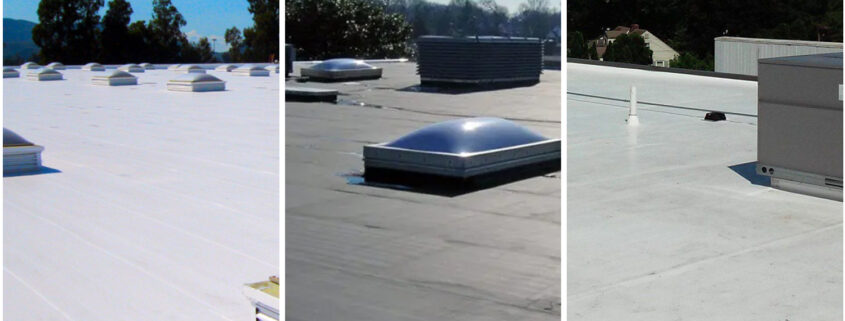Your commercial building is your most important asset – it keeps your products, equipment, and employees safe. Without it, daily operations just wouldn’t be possible.
So, when you need a trusted new roof, single-ply roofing systems are a popular choice among business owners. But, is it the right fit for you?
If you’re looking to replace your existing roof and don’t know the difference between commercial roofing systems, you’re in the right place. We’ll break down the ins and outs of single-ply membrane roofing systems so you can see if it’s a good fit for your next roof.
What Are Single-Ply Roofing Membranes?
When it comes to low-slope roofs, you have a number of options to choose from. BUR and modified bitumen roofing are popular – along with single-ply roofing systems. But, if you’re not in the roofing industry, you may not know what a single-ply roof is – and that’s ok. We can explain.
Single-ply roofing systems are membranes made out of flexible synthetic polymers or rubber.
During roofing installations, these membranes are applied as a single layer to the flat roof. There are different single-ply roofing materials available that have varying strengths and weaknesses – but there are a few pros and cons that are shared by them all.
Pros of Single-Ply Roofing Membranes
Ease of Installation
Since single-ply roofing materials are installed as a single layer. Depending on the size of your commercial roofing system, it may take just a few days to complete. This is much quicker than other roofing systems, which makes it a cost-effective option.
Durability
Single-ply roofs are designed to be resistant to UV radiation, can withstand high winds and hold up well in various climates.
Water-Tight Seams
Single-ply roofs have extremely strong seams when properly welded. This makes those seams water-tight, especially when applied to the roof deck with adhesives rather than being mechanically fastened. Single-ply roofing is an excellent roofing solution when it comes to waterproofing your building.
Energy Efficiency
Many single-ply roofing materials have high reflectivity against UV rays (aka cool roofs), which can help lower your energy costs.
Resistance to Chemicals
Roofing systems, such as EPDM and PVC, are made to be resistant to chemicals. They are an especially popular choice for industrial buildings.
Cons of Single-Ply Roofing Membranes
Vulnerable to Punctures and Penetrations
Sharp objects and heavy foot traffic can easily damage single-ply membranes. Regular maintenance and protective walkway paths can help curb these issues.
Seam Degradation
Over time, seams may wear and become more susceptible to damage. It’s important to check on the health of the roof regularly to make sure your seams are still holding strong.
Improper Installation Process Can Hurt Performance
If you don’t use the right fasteners with the right type of single-ply roofing material, or if the seams aren’t properly sealed, roofing issues can pop up later down the line.
While single-ply roofing installations are more cost-effective than other systems, you still want to make sure to hire a trusted commercial roofing contractor who gets the job done right.
Types of Single-Ply Membranes
The three most common types of single-ply membranes are PVC, TPO, and Thermoset/EPDM roofing systems. While they are all part of the single-ply family, each has its own manufacturing process, as well as its own strengths and weaknesses.
Here’s a quick overview of each so you can choose the right fit for your roof.
PVC Roofing
Polyvinyl chloride (PVC) is a thermoplastic polymer made through a process called calendering. This process involves the PVC compound being heated and compressed between rollers until a sheet of uniform thickness is produced.
PVC membranes are known for being eco-friendly and highly durable. They typically have a lifespan similar to modified bitumen or built-up roofing systems. In fact, with proper maintenance, they can last up to 30 years. They’re highly fire-resistant and great at withstanding high winds.
However, PVC is one of the more costly single-ply membranes, and they may crack or shatter in cold temperatures.
TPO
Thermoplastic polyolefin (TPO) is made from a blend of polypropylene and ethylene-propylene rubber. TPO membranes are produced through an extrusion process where the blend is heated and pushed through a die that results in sheets that are a consistent width.
TPO roofing systems are the newest and most energy-efficient thermoplastic membrane available and the most energy-efficient of all common commercial roofing options. It’s also very cost-effective.
However, the jury is still out on TPO’s lifespan. Keep in mind that they tend to not do well in hot climates because they shrink when overheated.
EPDM Roofing Systems
Ethylene propylene diene monomer (EPDM) is a synthetic rubber. Like TPO, it’s made through an extrusion process where the compound is heated and forced through a die.
This is the best option for cold climates, as it provides great energy efficiency in the winter. Overall, EPDM roofing membranes have great weather resistance. Like TPO, however, they can shrink in hot climates, and they’re susceptible to punctures. It has a similar lifespan to PVC.
Get the Best Fit For You
Single-ply roofing membranes can be a great choice for a commercial building, but ultimately that will depend on what your needs are.
No matter what roofing material is right for you, quality roofing starts and ends with quality work. The installation process is important – remember, shoddy workmanship can compromise your roof’s lifespan later down the line. That’s why it’s important to go with a trusted roofing contractor.
TEMA Roofing has decades of experience providing roofing solutions spanning many industries across the nation. When you’re looking for someone to depend on for your new roofing system, look no further. Contact us today and put TEMA on your team!





